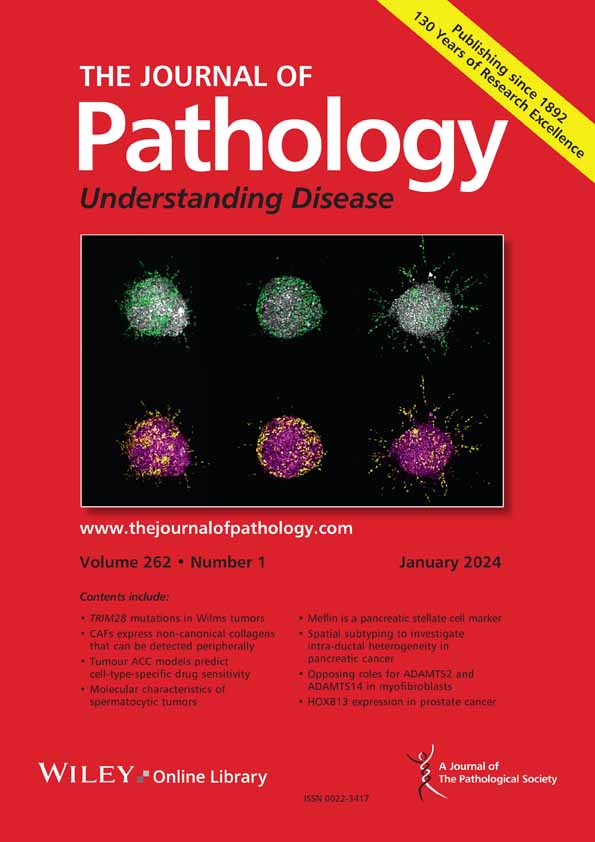Paola Defilippi, Francesca Nigrelli, Pietro Arina, Daniela Taverna, Vincenzo Salemme
下载PDF
{"title":"A breast cancer PDX collection enriched in luminal (ER+) tumors and young premenopausal patients to identify new therapeutic strategies for high-risk patients†","authors":"Paola Defilippi, Francesca Nigrelli, Pietro Arina, Daniela Taverna, Vincenzo Salemme","doi":"10.1002/path.6418","DOIUrl":null,"url":null,"abstract":"<p>Breast cancer includes a group of neoplasms originating from mammary gland epithelial cells caused by a variety of genetic alterations, with different responses to treatments and outcomes. In clinical practice, estrogen receptor (ER), progesterone receptor (PR), and human epidermal growth factor receptor 2 (HER2) expression guides the distinction between luminal A (ER<sup>+</sup>, PR<sup>+</sup>, HER2<sup>−</sup>), luminal B (ER<sup>+</sup>, PR<sup>+</sup>, HER2<sup>+/−</sup>), and triple-negative (ER<sup>−</sup>, PR<sup>−</sup>, HER2<sup>−</sup>), each with a distinct biological behavior and clinical and therapeutic implications. Approximately 11% of breast cancers are diagnosed in young premenopausal women aged 20–49 years. Patient-derived xenografts (PDXs) offer a powerful solution to integrate personalized medicine and novel therapeutic agents. Dr Belletti's group recently developed a PDX biobank composed of 26 PDX lines highly enriched in luminal A and B and young premenopausal breast cancer patients. The bank faithfully recapitulates the characteristics of the original tumors. A major focus of their research was to exploit these PDXs to assess the resistance to CDK4/6 inhibitors (CDK4/6i), which are critical in managing advanced luminal breast cancers. Their effort addresses a significant gap in existing PDX models, which are limited for these patient subgroups, thereby enabling deeper insights into tumor biology and therapeutic responses in these understudied populations. © 2025 The Author(s). <i>The Journal of Pathology</i> published by John Wiley & Sons Ltd on behalf of The Pathological Society of Great Britain and Ireland.</p>","PeriodicalId":232,"journal":{"name":"The Journal of Pathology","volume":"266 2","pages":"125-129"},"PeriodicalIF":5.2000,"publicationDate":"2025-03-27","publicationTypes":"Journal Article","fieldsOfStudy":null,"isOpenAccess":false,"openAccessPdf":"https://onlinelibrary.wiley.com/doi/epdf/10.1002/path.6418","citationCount":"0","resultStr":null,"platform":"Semanticscholar","paperid":null,"PeriodicalName":"The Journal of Pathology","FirstCategoryId":"3","ListUrlMain":"https://pathsocjournals.onlinelibrary.wiley.com/doi/10.1002/path.6418","RegionNum":2,"RegionCategory":"医学","ArticlePicture":[],"TitleCN":null,"AbstractTextCN":null,"PMCID":null,"EPubDate":"","PubModel":"","JCR":"Q1","JCRName":"ONCOLOGY","Score":null,"Total":0}
引用次数: 0
引用
批量引用
Abstract
Breast cancer includes a group of neoplasms originating from mammary gland epithelial cells caused by a variety of genetic alterations, with different responses to treatments and outcomes. In clinical practice, estrogen receptor (ER), progesterone receptor (PR), and human epidermal growth factor receptor 2 (HER2) expression guides the distinction between luminal A (ER+ , PR+ , HER2− ), luminal B (ER+ , PR+ , HER2+/− ), and triple-negative (ER− , PR− , HER2− ), each with a distinct biological behavior and clinical and therapeutic implications. Approximately 11% of breast cancers are diagnosed in young premenopausal women aged 20–49 years. Patient-derived xenografts (PDXs) offer a powerful solution to integrate personalized medicine and novel therapeutic agents. Dr Belletti's group recently developed a PDX biobank composed of 26 PDX lines highly enriched in luminal A and B and young premenopausal breast cancer patients. The bank faithfully recapitulates the characteristics of the original tumors. A major focus of their research was to exploit these PDXs to assess the resistance to CDK4/6 inhibitors (CDK4/6i), which are critical in managing advanced luminal breast cancers. Their effort addresses a significant gap in existing PDX models, which are limited for these patient subgroups, thereby enabling deeper insights into tumor biology and therapeutic responses in these understudied populations. © 2025 The Author(s). The Journal of Pathology published by John Wiley & Sons Ltd on behalf of The Pathological Society of Great Britain and Ireland.
一种富含腔内(ER+)肿瘤和年轻绝经前患者的乳腺癌PDX集合,以确定高风险患者的新治疗策略
乳腺癌包括一组起源于乳腺上皮细胞的肿瘤,由多种遗传改变引起,对治疗和结果的反应不同。在临床实践中,雌激素受体(ER)、孕激素受体(PR)和人表皮生长因子受体2 (HER2)的表达指导了腔内A (ER+、PR+、HER2-)、腔内B (ER+、PR+、HER2+/-)和三阴性(ER-、PR-、HER2-)的区分,每种都具有不同的生物学行为和临床和治疗意义。大约11%的乳腺癌是在20-49岁的年轻绝经前妇女中被诊断出来的。患者来源的异种移植物(PDXs)提供了一个强大的解决方案,将个性化医疗和新型治疗药物相结合。Belletti博士的研究小组最近开发了一个PDX生物库,由26个高度富集腔内a和B的PDX系和年轻的绝经前乳腺癌患者组成。该库忠实地再现了原始肿瘤的特征。他们研究的一个主要重点是利用这些pdx来评估对CDK4/6抑制剂(CDK4/6i)的耐药性,CDK4/6i对晚期腔内乳腺癌的治疗至关重要。他们的努力解决了现有PDX模型的重大空白,这些模型仅限于这些患者亚组,从而能够更深入地了解这些未充分研究人群的肿瘤生物学和治疗反应。©2025作者。《病理学杂志》由John Wiley & Sons Ltd代表大不列颠和爱尔兰病理学会出版。
本文章由计算机程序翻译,如有差异,请以英文原文为准。







 求助内容:
求助内容: 应助结果提醒方式:
应助结果提醒方式:


